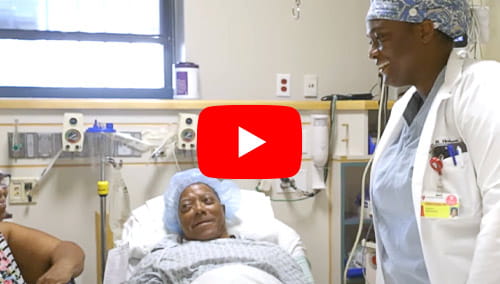
Astrocytomas
University Hospitals Seidman Cancer Center’s physicians and oncologists are national leaders in the diagnosis and treatment of astrocytomas, adapting treatment to each patient’s age, health conditions and individual needs. As one of the best cancer hospitals in the country by U.S. News & World Report for over 20 years, UH Seidman Cancer Center is part of the National Cancer Institute (NCI)-designated Case Comprehensive Cancer Center at Case Western Reserve University School of Medicine – one of an elite group of 53 such comprehensive cancer hospitals in the U.S.
Your health is important. Make an appointment today.
Offering in-person, video and telephone visits. Call todayto see which option is right for you. 216-844-3951
Learn more about virtual visits
What are Astrocytomas?
Astrocytoma is a type of glioma, which is class of tumors that begin in the glial cells – the supportive cells that surround, support and protect nerve cells (neurons). The type of glial cells involved in astrocytomas are star-shaped cells called astrocytes.
Astrocytomas are the most common malignant (cancerous) brain tumors diagnosed in adults and children. Approximately 15,000 new astrocytomas are diagnosed every year in the U.S.
Like other types of brain tumors, astrocytomas are categorized into grades that indicate how abnormal the tumor cells appear under a microscope, the tumor’s rate of growth, the presence of newly made blood vessels within the tumor (vascular proliferation) and the likelihood of the tumor spreading. The World Health Organization (WHO) classification of astrocytoma grades is as follows:
- Grade 1
-
- Pilocytic Astrocytoma: A well-circumscribed, slow-growing tumor; most commonly found in the cerebellum; does not spread to surrounding brain tissue; is considered cured when resected (removed) completely; does not require either chemotherapy or radiotherapy.
- Pleomorphic Xantoastrocytoma: Most often develops in the temporal lobes; commonly associated with seizures; the tumor cells can have many different shapes (pleomorphic), but generally do not show evidence of proliferation; usually curable with surgery.
- Subependymal Giant Cell Astrocytoma (SEGA): More common in younger patients and usually develops in association with the genetic syndrome tuberous sclerosis; develops inside the ventricles, which are cerebrospinal fluid-filled spaces deep inside the brain; can block the normal outflow of cerebrospinal fluid to cause hydrocephalus. Surgical resection is usually curative.
- Grade 2
-
Diffuse Astrocytoma: An invasive tumor with no clear separation from surrounding brain tissue; surgery itself may not be enough to cure it; tumor tissue appears similar to normal brain tissue, but cells appear abnormal under the microscope.
- Grade 3
-
Anaplastic Astrocytoma: A more malignant evolution of a previously lower grade astrocytoma with more aggressive features, including faster growth and more invasion into surrounding areas of the brain; displays a higher degree of cellular abnormalities and evidence of cell proliferation (mitoses) in comparison to grade 2 astrocytomas; surgery is never considered curative for these tumors and must be followed with radiation usually combined with chemotherapy.
- Grade 4
-
Glioblastoma: Also known as glioblastoma multiforme (GBM), glioblastoma is the most aggressive form of astrocytoma and the most common type of astrocytoma diagnosed in adults. It is characterized by very abnormal-looking cells, high cell proliferation (mitoses), areas of dead tissue and the formation of new blood vessels. Glioblastoma can develop from a previously existing lower grade astrocytoma (about 10% of cases) or originate directly as a grade 4 tumor (90% of cases). The former scenario occurs more often in younger individuals, while the latter is most prevalent in people age 60 and older.
What Are Astrocytoma Symptoms?
Symptoms of astrocytoma brain tumors can include the following:
- Persistent headaches
- Headaches which are worse in the morning or disrupt sleep (a sign of increased intracranial pressure)
- Blurred or double vision
- Difficulty speaking
- Decreased cognitive abilities
- Grasp or limb weakness
- Seizures
- Altered sensations, including strange smells and hallucinations relating to sense of smell
- Behavior, mood or personality changes
- Difficulty with balance
- Dizziness
- Memory loss
- Muscular weakness on one side of body and loss of control of bodily movements
- Nausea and vomiting
Other health problems can cause many of the above symptoms. See a health care provider if you have these symptoms. Only a health care provider can determine if you have a brain tumor or not.

Astrocytoma Causes and Risk Factors
The causes of astrocytoma are not fully understood. Many cases of astrocytoma appear to be random events. However, a few risk factors have been identified, including:
- Being between the ages of 45 and 65
- Having a family history of gliomas
- Exposure to ionizing radiation, ultraviolet rays or certain chemicals
Also, astrocytomas occur more frequently in individuals with certain genetic disorders, among them Turcot syndrome, neurofibromatosis type 1, tuberous sclerosis, Ollier’s disease and Li-Fraumeni syndrome. In addition, males are slightly more affected by astrocytomas than females, with a ratio of 1.3 to 1.
Astrocytoma Prognosis
Doctors can never be absolutely certain about the specific outcome for a patient following a brain tumor diagnosis. They can provide an estimate but may not be able to predict other factors, such as how well a patient responds to treatment. As such, prognosis can be revised at different stages of the care journey.
Survival Rates for Astrocytomas
Grade 1 - Low-grade
The majority of grade 1 astrocytomas are cured by surgery only. Patients diagnosed with this type of tumor have a 96% survival rate at five years.
Grade 2 - Low-grade
The average survival time after surgery is six to eight years. More than 40% of people with a low- astrocytoma live more than ten years.
Grade 3 - High-grade
Approximately 27% of people diagnosed with a high-grade astrocytoma live for five years or more.
Grade 4 - Glioblastoma
The average survival time for glioblastoma patients is 12 to 18 months following diagnosis. About 25% of glioblastoma patients survive more than one year; only 5% of patients survive more than five years.
Note that these figures do not indicate how long a person will live past the given ranges. For example, depending on their circumstances, a patient who is a 5-year glioblastoma survivor might live as long as any other healthy person.
Astrocytoma Treatment
Leveraging some of the most advanced brain cancer treatments available and conducting groundbreaking clinical trials, UH Seidman Cancer Center’s physicians have contributed to a number of innovations in the treatment of astrocytomas and other types of brain tumors. Our dedication to clinical research means we offer our patients access to advanced treatments and therapies sooner than most other hospitals.
Treatment for astrocytoma is based on the type of astrocytoma, the location of the tumor, the speed at which the tumor is growing and the patient’s unique set of symptoms. Treatment plans may include one or more of the following:
- Surgery
-
Surgery may be used in both the diagnosis and treatment of astrocytomas. Surgical removal of the tumor helps reduce pressure on nearby parts of the brain. Surgery may be followed by chemotherapy or a combination of chemotherapy and radiation therapy.
Working closely with specialists from University Hospitals Neurological Institute’s Brain Tumor and Neuro-Oncology Center our fellowship-trained neurosurgeons utilize the latest advances in surgical intervention to treat astrocytomas, including:
- Minimally invasive brain tumor surgery: This approach includes endoscopic techniques through which our neurosurgeons view detailed images of the patient’s brain using a small camera.
- Fluorescence-guided surgery: UH Seidman Cancer Center neurosurgeons have pioneered use of special fluorescent markers (such as 5-ALA) to assist in precisely identifying the borders of a tumor in order to help the surgeon remove more of it while minimizing risk to the brain.
- NeuroBlate®: This revolutionary laser interstitial thermal therapy destroys brain tumor tissue with a magnetic resonance imaging (MRI)-guided laser. Our hospital is one of only a handful in the world that offers this minimally invasive treatment, which can be used to treat brain tumors that were previously diagnosed as untreatable.
- Intraoperative MRI: At out specialized intraoperative MRI suites, we utilize magnetic resonance imaging to track surgical progress in real-time.
- Radiation Therapy
-
Radiation therapy involves the use of high-energy x-rays or other types of radiation to kill cancer cells or prevent them from growing. Using a machine outside the body, external radiation therapy sends radiation directly toward the area of the tumor. This therapy is often recommended after surgery and may be administered in combination with chemotherapy. For patients who can’t undergo surgery, radiation therapy and chemotherapy may be used as a primary treatment.
Innovative radiation technologies that we use in the treatment of astrocytomas include:
- Proton therapy: UH Seidman Cancer Center is the first hospital in Northeast Ohio to offer this innovative, powerful and technologically advanced therapy. Effective for both adults and children, proton therapy has less side effects than other forms of radiation therapy, resulting in better quality of life during treatment, while also reducing patient risk for the development of radiation-induced secondary cancers decades after treatment.
- Stereotactic Radiosurgery
-
Radiation therapy involves the use of high-energy x-rays or other types of radiation to kill cancer cells or prevent them from growing. Using a machine outside the body, external radiation therapy sends radiation directly toward the area of the tumor. Stereotactic radiosurgery differs from traditional radiation therapy in that stereotactic radiosurgery involves the use of precisely focused radiation beams. Unlike traditional radiation therapy, stereotactic radiosurgery exposes very little if any normal tissue to radiation.
Stereotactic radiosurgery is often recommended after conventional surgery and may be administered in combination with chemotherapy. For patients who can’t undergo conventional surgery, stereotactic radiosurgery and chemotherapy may be used as a primary treatment.
Innovative stereotactic radiosurgery technologies we use in the treatment of astrocytomas include:
- Gamma Knife®: An accurate form of stereotactic radiosurgery for the brain, this technology pinpoints a single area with numerous gamma radiation beams without damaging surrounding healthy tissue.
- Varian Edge™: This advanced, high-focus radiation beam radiosurgery system targets the DNA in cancer cells, destroying the cells. Unlike other radiosurgery systems that require the use of a rigid frame to secure a brain cancer patient’s skull during treatment sessions that can last several hours, Varian Edge delivers equally precise treatment without requiring a frame in as little as just a few minutes.
- Chemotherapy
-
Chemotherapy uses drugs to stop the growth of cancer cells, either by killing the cells or preventing their division. When appropriate, your surgeon may use an innovative technique in which thin, circular wafers containing chemotherapy medicine are placed in the brain during surgery. These wafers dissolve slowly to provide the timed release of a medicine that kills cancer cells.
- Tumor Treating Fields (TTF) Therapy
-
TTF utilizes an electrical field to impede the ability of a tumor’s cells to multiply. In TTF, adhesive pads connected to a portable device that generates an electrical field are applied to the patient’s scalp. This therapy is combined with chemotherapy and may be suitable following radiation therapy.
- Targeted Drug Therapy
-
Targeted therapy is an approach to treatment that utilizes drugs or other substances to identify and attack specific cancer cells. In general, targeted therapies cause less harm to normal cells than chemotherapy or radiation therapy. Promising targeted therapies for the treatment of astrocytomas include monoclonal antibody therapy, tyrosine kinase inhibitor therapy and vascular endothelial growth factor (VEGF) inhibitor therapy.

Pioneering Clinical Research Leads to New Opportunities in Care
University Hospitals is an affiliate of Case Western Reserve University School of Medicine, a nationally recognized leader in clinical research. UH Seidman Cancer Center currently conducts clinical trials for patients with astrocytomas and other types of brain tumors, giving patients access to new and innovative therapies and treatment options.
A Team of Highly Trained, Compassionate Experts
Our multidisciplinary group evaluates and reviews every case so that diagnosis and treatment decisions are based on the team’s combined expertise. Together, we work through every step of cancer care, always with a cure in mind, always with a focus on obtaining the best possible outcome for the patient. Our care team comprises:
- Genetic counselors
- Medical geneticists
- Medical oncologists
- Nurse navigators
- Nurse practitioners
- Pathologists
- Radiation oncologists
- Radiologists
- Social workers
- Surgical oncologists
At UH Seidman Cancer Center, each patient’s case is presented at weekly tumor board meetings, where our team conducts a disease-specific tumor board review to ensure that all treatment options are considered.
Reasons to Choose UH Seidman Cancer Center for Astrocytoma Treatment
Member of the Adult Brain Tumor Consortium, a consortium of 11 elite Centers of Excellence for brain tumors.
Provides astrocytoma patients with innovative clinical trials
The first stereotactic radiosurgery suite in Ohio to offer Gamma Knife® technology for malignant and benign brain tumors
The first hospital in Ohio to offer proton therapy – an innovative, technologically advanced cancer treatment
The second provider east of the Mississippi to offer Medtronic’s Stealth Autoguide precision robotic platform for brain surgery
The first cancer center to offer GammaTile®, a form of radiation that dissolves in the patient’s brain after placement at the end of brain surgery
One of the leading centers in the country for minimally invasive (Laser Interstitial Thermotherapy) combined with immunotherapy
Frances’ Story: The Stars Align
After years of catering to the stars, Frances Noonan has an eye for the best. The Colorado woman also knows one’s luck can change in an instant, and traveling for a better experience can be well worth the trip.



